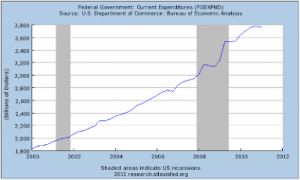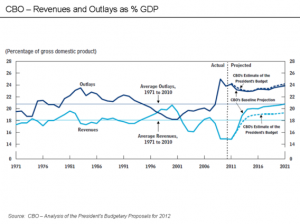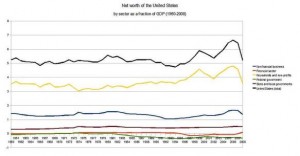It has become increasingly clear in our national debate concerning THE FISCAL CLIFF (add echo effect) many people do not understand Debt, Deficit Spending, Taxes, and our GNP and these misunderstandings are influencing policy decisions.
It seems that many people are using the concept of “taxes” to mean our national “income” yet, taxes are not. Taxes are the fees that we pay to operate this country. Ideally, taxes and federal spending should be balanced, but reversing a recession requires liquidity from stimulus that can offset that balance until recovery.
Our national “income” is our Gross National Product; what is paid for what we produce. The mistake I’ve heard many times is from people who are looking at our tax revenue and comparing it to our debt and they come away stunned because the two are so far apart. Right leaning news sources then fan that misconception so that people will believe that our tax to debt ratio is so out of whack that it is destroying us. And that it’s all President Obama’s fault.
President Obama, for the record, has been reducing non-military discretionary spending. Several biased media have cited how Obama has spent more than all Presidents combined but from 2000 to 2008, under President Bush, Federal spending rose by $1.3 trillion, from $1.9 trillion a year to $3.2 trillion a year. From 2009 to 2011, meanwhile,  under President Obama, federal spending has risen by $600 billion, from $3.2 trillion a year to $3.8 trillion a year.
under President Obama, federal spending has risen by $600 billion, from $3.2 trillion a year to $3.8 trillion a year.
Federal government spending, therefore, under President Bush increased two times as much as it has under President Obama. It has also begun to decline.
Deficit Spending is what people are really talking about in terms of what we bring in with tax revenue compared to what we spend. It is also an interesting political divide. Until it became a Republican talking point to emphasize how “Democrats are spending out of control” it was embraced by GOP policy. None other than Dick Cheney said in 2000, “Deficits don’t matter.”

What he meant was, while balancing that ratio always appears to be a good thing, it can be used, and has, throughout Democratic and Republican administrations to stimulate the economy.
In a recession, for example, there can be nothing worse that limiting liquidity in the market; there has to be money flowing quickly and easily to stimulate spending and production. Government spending, even when it’s more than tax revenue, can reverse a recession trend and that ultimately creates more revenue so that the budget can balance.
Then there’s the 16 trillion pound gorilla; the Debt. Actually it’s $16,355,107,788,897 and counting. That is the money that the United States has borrowed and OWES to creditors.Daunting.

But, how many people know that the United States owns foreign assets totalling $11,500,000,000,000? Some of that ferocious growl goes away.
The overall financial position of the United States includes over $50 trillion of debt owed by US households, businesses, and government, which is more than 3.5 times the annual gross domestic product. However, domestic financial assets total $131 trillion and domestic financial liabilities $106 trillion. Tangible assets total an additional $56 trillion. And so, the net worth of the United States is around $75 trillion or 5.2 times GDP. That still makes us a pretty good investment.
What we need to address is where the money in America is flowing and then begin to create policy to balance that trend. A look at these charts will sober up any idea that wealthy Americans need to be subsidized even more. http://www.washingtonpost.com/blogs/wonkblog/wp/2012/12/27/2012-the-year-in-graphs/
Our Gross National Product (our income) is just below 15 trillion dollars annually. When Reagan was President it was around 4 trillion. That’s how much our economy has grown over the past 27 years and naturally our debt and expenditures have grown along with it. But, the United States is producing again and after the start of a serious recession in 2007 we are again showing GNP growth.

Suddenly that daunting debt number isn’t quite as scary. We are 25% of the entire world’s economy and it is in the best interest of every industrialized nation to support the United States economically speaking.
The path to prosperity requires that we understand our terms, that we investigate real numbers and listen to what economists are saying, and that our politicians step up with the guts to tell the truth.
References: Congressional Budget Office; Office of Management and Budget; U.S. Debt Clock.org; U.S. Dept. of the Treasury. http://en.wikipedia.org/wiki/US_total_cumulative_debt_per_person